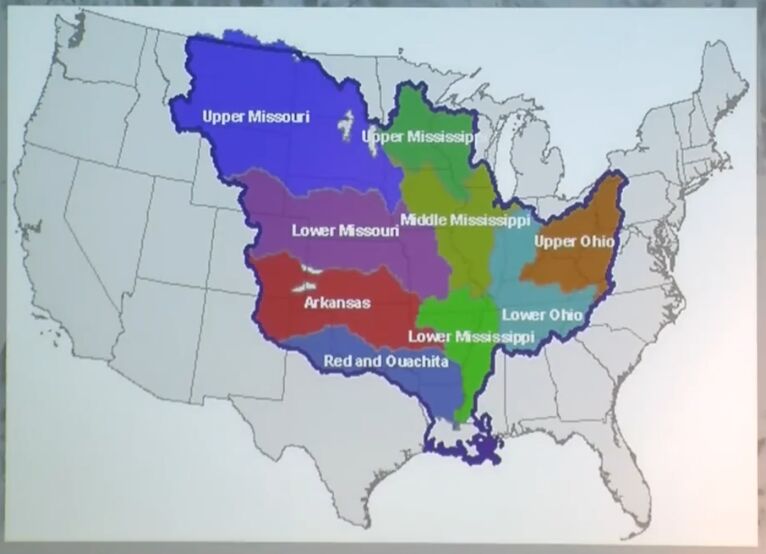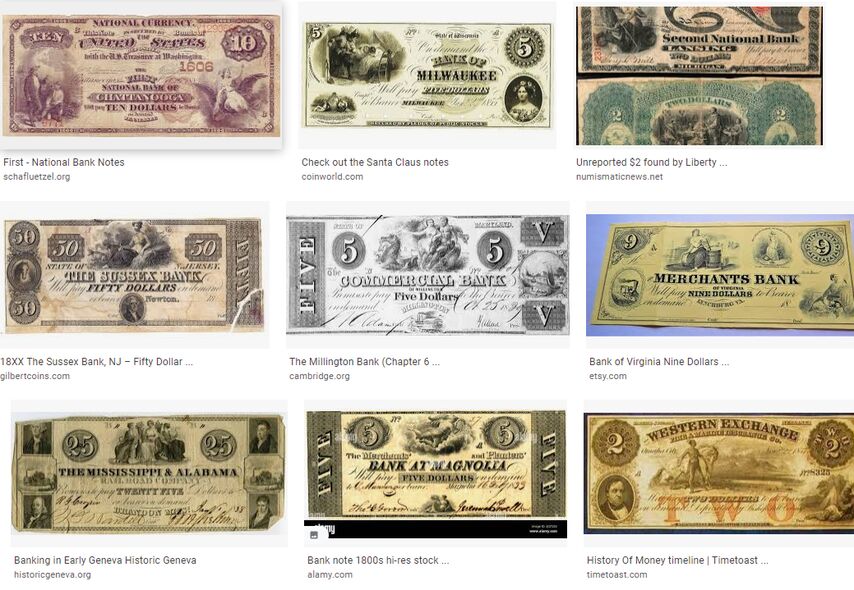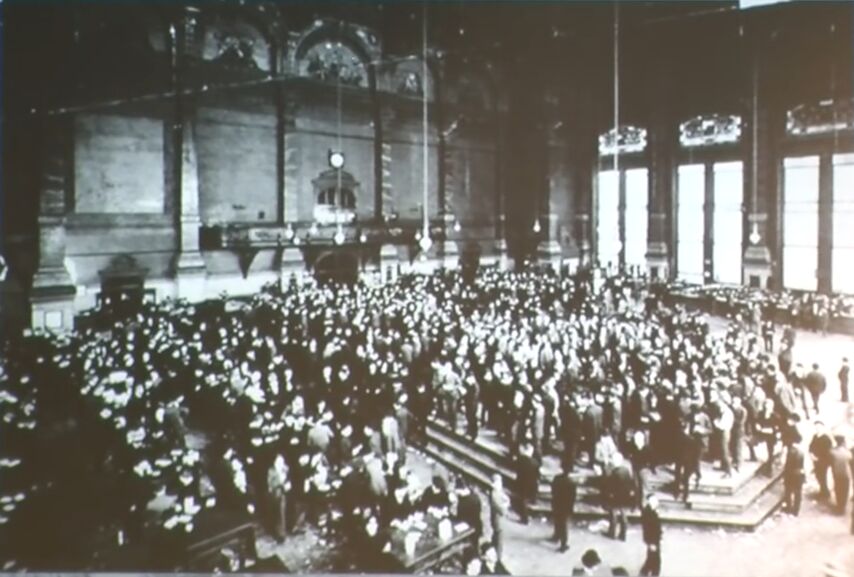This story began in what is called the northwest United States in the first half of the 1800s.

The events that we are going to talk about at first mainly took place in the eastern part of the highlighted area – Ohio and Mississippi. But, gradually they covered the entire region.
These territories were sparsely populated and very poor. No roads or cities, just a lot of swamps, mountains and rivers. Movement was very difficult. There was a constant war on these lands – from 1800 to about 1880, the so-called Indian Wars. I am talking about large and well-equipped armies, as well as raids by small detachments of several dozen people. In general, these territories were among the poorest on the whole of the planet.
Who inhabited them at the beginning of the 19th century? Does anybody know?
– Gold diggers? suggested a member of the audience.
They came a little later, but yeah there were some. First of all, there lived the indigenous peoples of the United States, some of whom were driven from other territories in the south and east. And from the north, too – French-speaking Indians from Canada, who were forced out by the British. Rebels from the USA were exiled here, for example, participants in the Whiskey Rebellion. Fugitive slaves, debtors... People who had no hope of paying their debts wrote on the doors of their houses the letters "GTT" – "Gone to Texas" – and moved to these parts. In general, we have a territory inhabited by misfits, with constant violence and without many economic resources.
A few years ago, they compiled a list of the hundred richest Americans in history. An estimate of their fortunes in the contemporary US economy was made. 90 of the 100 richest Americans of all time lived in the Northwest region from 1850-1880. How could this happen? How did this poor and unpromising region, where it is not clear how one can get rich in principle, give birth to so many incredibly rich people?

It's not about natural resources. Yes, some of them found gold or oil, but there were also great inventors and pioneers of new industries on the list: McCormick, Westinghouse, Pullman, [Gustavus Franklin] Swift, Pulitzer, [William Randolph] Hirst, [Philip Danforth] Armor, Marshall Field... These names are known to everyone today. And now, dear listeners, try to name me other nineteenth-century business pioneers from any other country in the world! Of course, individual breakthroughs in science and technology could occur anywhere, but modern business most definitely originated in this region. What made it different? Is there something in the water? In the air? What did they have that they didn't have anywhere else?
(Voice from the audience: "Cheap labor?")
No, on the contrary, labor was very expensive, because it was a huge and sparsely populated territory, that is, there were few people, and it was difficult to get anywhere.
Okay, I'll answer: they had a game called poker.
I hear laughter in the hall. Let's see if you will laugh after the end of our lecture.
The first written mentions of poker date back to the late 1820s and early 1830s, and what is much more interesting is what they do not talk about. They don't say, "People play poker here, and this is what the game is:..." No one explains the rules. Strange, right? Moreover, they don't even talk about poker as a game! The only thing that can be understood from these notes is that poker is associated with the transfer of large sums of money from hand to hand. They do not write that in one area they play one kind of poker, and in another they play another, they do not try to explain anything to the reader about poker. It can be seen from the notes that everyone around was well aware of what poker was, how it was played, how serious it was and how large bets could be.
Nowhere is it mentioned that poker was brought here from somewhere else, that it was played in India, Persia, or somewhere else.
It showed up right here.
Here are some more interesting facts about this game. Firstly, as we know, at all times ordinary gambling has been much more popular than poker. Toss, dice and various varieties of roulette were played all over the world and in all social classes. Secondly, there were more complex games popular with aristocrats such as chess. These games were not always associated with gambling or excitement and required considerable skill. Poker nestled somewhere in between.
How else was poker different from all the games in the history of mankind that appeared before it? Maybe the answer to this question will help us understand what happened here.
For starters: an ace beats a king – today it is commonplace, but for the beginning of the 19th century the concept was revolutionary, and in most countries of the world you could be executed for such a statement. By the way, in early poker, the ace was always a strong card, it was never played as a low card. It seems that the creator of poker was not a monarchist.
The strength of combinations directly depends on their rarity: the rarer the combination, the stronger it is. In the earliest versions of poker, there were no straights or flushes. However, there was one difference from the current rules. Until about the 1830s, the principle of rarity of combination was applied even more consistently than it is now. When we compare hands of two similar types today, say with a pair or no pair, the winner is determined by the highest next card. If you take all combinations without pairs, A-high will occur most often, and at the same time they are the strongest. But this is a violation of the principle of rarity! In early poker, they compared from below, that is, they first looked at the weakest of your cards, and if two players had the same, then you look at the next one. The winner, as in lowball, was the owner of a rarer, that is, weaker combination in the modern sense.
The use of such rules drastically reduces the value of the ace. If two players don't have a showdown, in modern poker, having A-high gives me an 83% chance of winning. According to the old rules, an ace gives 56% to win. There is almost no difference between the ace and the face cards, because the winner is most likely to be determined by the lowest card.

This game was developed on the basis of rational thinking and mathematics, quite advanced mathematics for that time. Poker was not a game that evolved over the centuries. It was designed.
The process of the game, however, was quite simple. "Straight Poker", as it was called then, was played like this: first you were dealt a card, then there was a round of betting, then a second card was dealt, this was followed by another round of betting, the third card was the third round of betting, after which the last two cards were dealt together , already then called "turn" and "river", and there was no final round of betting.
There was no ante. There were no modern blinds either. The betting in the first round was quite clever (the inventor did his best!): the dealer dealt cards, after which the person to the left of the dealer, who was called "age", had to, without looking at his card, make any bet he wanted – including zero! Yes, it was possible not to bet anything. (I'm only talking about the first round, all other rounds of betting were exactly the same as in modern poker.) And the trick is that in the first round, other players were not allowed to call the age bet. If the age bet a dollar, you could either fold or raise. This makes the position of the age more advantageous than the player who posts the big blind in modern poker. Maybe the age is closer to our small blind, although in those days the rules did not force the next player to double the age bet.
This allowed the poker players of that time to confidently assert that poker had nothing to do with gambling, because in poker no one is forced to make a bet. You look at your cards and if you consider your expectation to be positive (although such terms were not used then), then you enter the hand.
Based on experience, it was believed that the right to "post the blind" gives the player a small advantage: the other players must either give up or double the bet. Mathematically it is easy to prove that this is not true, but psychologically and empirically in those days it was true.
It is important that at the end of each round of betting, all players remaining in the game bid the same amount. In essence, the betting was about which hand had the highest chance of winning at showdown.

It didn't last long. Around the 1840s and 1850s, these rigid rules came under intense pressure. Antes appeared. Combinations of "straight" and "flush" were added. Finally, bets were added after the last cards, which made it possible to bluff. New forms of poker began to appear – draw poker; stud in which everyone sees some of your cards, and so on. The game began to change.
Robert Frederick Foster was the first to publish a book in which he analyzed the history of poker in detail. An old conservative game with very rigid principles which has gradually evolved into a modern one, much more exciting, fun and, obviously, gambling. It is even played for other purposes. But more about that later.
We talked about cards and bets. It's time to touch on the most revolutionary innovation that came along with poker and made it so unique.
Gambling has existed at all times and all over the planet. Every culture has its own forms of gambling. Gambling is played with money or goods. When playing on credit, the organizer, who is trusted by the participants, solves the problems: he conducts the game and he also takes care of the loans.
Poker was not played for money and was not played for goods. Poker in those days was played for the so-called "poker checks", and this situation continued until the 1980s, until it was completely eradicated. Even when I was playing in the 80s, there were both poker chips and poker checks in the game. Outwardly, they were similar, but the check had its own value, like money, they paid off like money. Also they were used for any other games. Whereas poker chips were just candy wrappers: they were bought at the poker table and cashed out immediately after the game; they could not be taken with them to play roulette or craps. They had no intrinsic value.
The history associated with this is long and interesting, and I will talk about it sometime in the future. In short, the IRS, the Internal Revenue Service, put an end to poker checks while fighting organized crime. Now there are no poker checks – at least legal ones. Chips are not money. If you walk into a casino with a $5,000 chip and want to cash it out, you will be asked where you got it, you will be asked to prove that you bought or won it at the casino, and if your proof fails, they will not give you the money.

Okay, back to the beginning of the 19th century. Poker was played with poker checks. They were usually made of clay, these little discs that had a thumbprint or some other personal identifier that tied the check to a particular person. You played poker with money that you printed yourself! When you lost, your checks fell into the hands of other people and became debt obligations. When you won, you received the losers' checks. After the end of the game, the participants exchanged checks – everyone tried to return as many of their own as possible in exchange for others.
Under such a system, the winners were engaged in collecting money from the losers, there was no responsibility of the organizer, no third party in this matter. If you didn't like someone's checks, if you couldn't find a use for them, that was your problem.
Thus, poker players invented new money, created their own form of credit. That was the key element of early poker.
Let's remember another financial institution that arose at that time and in the same region – a speculative bank (wildcat bank). People created banks simply by announcing: I have a bank! I will issue loans and accept deposits! Sometimes they printed their own banknotes, sometimes very primitive ones. If it worked, economic activity skyrocketed, loans paid off, deposits returned, great. If it did not work, the banknotes were completely worthless.

Today any bank operates as a speculative bank. Capital is just an extra touch that adds credibility to it in the eyes of the public. People know that the owner of a bank in case of bankruptcy risks losing his personal money. In theory, this capital should allow the return of part of the funds to depositors who have lost their deposits, in practice this never happens – bankers always have time to withdraw their capital before the bank collapses. However, for some reason, most people have a completely wrong idea about the banking system – they think that all their money is backed.
Almost all human cultures have had different forms of credit creation. Poker has become one of them. To play the game, you print your own money. If you win, you get credit from other players and use it to generate economic activity. If you lose, others have to hire you – you have to somehow repay the debt, but you have no money. They have to come up with a job for you. This is how many businesses in the Old West were born.
Fast forward a few years to the 1840s.

Does anyone know what this is? This is the Chicago Board of Trade. A photograph from the beginning of the 20th century, in 1840 it wasn't so fancy. All these people are engaged in futures trading of agricultural products. Futures trading appeared everywhere about 20 years later and in exactly the same region in which poker appeared. No one introduced it, no one invented it, just here and there all over the region, chambers of commerce suddenly began to appear, financial institutions that had never existed in the history of mankind. They turned out to be natural for the way of thinking of the people who inhabited these lands.
The poker analogy is very clear. You bet on the price of wheat three months from now, constantly summing up, recalculating from the old rates, and so on. By the way, chambers of commerce were created exclusively by poker players. I'm not joking – all the names are known, you can study the topic. All of them were poker players.
Chambers of Commerce out of the blue created huge credit and offered an innovative service. Let me remind you that all this took place in a territory where there was no reliable money: there was little gold and silver, and the state banking system did not exist – It had to turn around somehow! And it began to spin in such a way that an economic boom began in the region, which shook the whole world.












